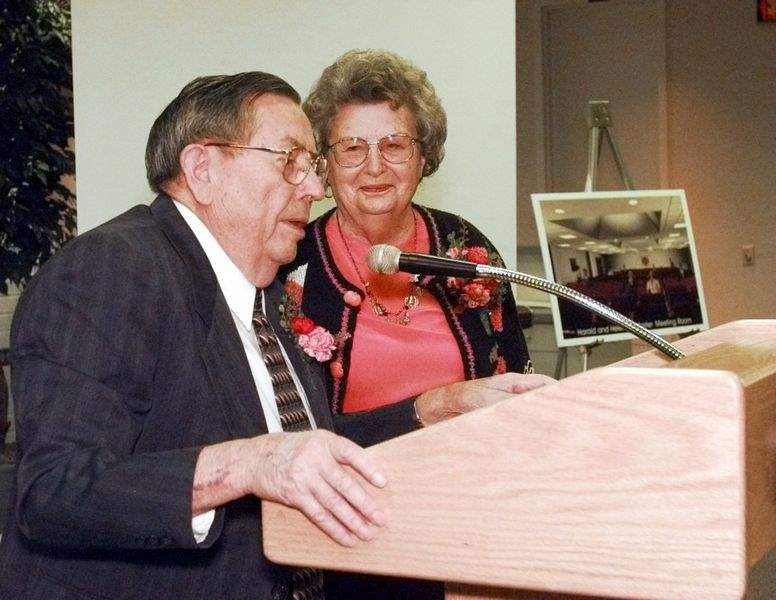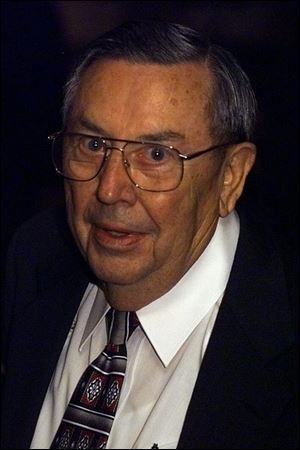
Inventor became philanthropist
8/26/2003
Mr. McMaster and his wife, Helen, are feted at the Mileti Alumni Center at Bowling Green State University in October, 1999, for their donation of $750,000 to the university.
FRASER / BLADE
Harold A. McMaster, the Henry County farm boy who became one of the country's leading glass industry inventors, a pioneer in the commercial use of solar energy, and a giant among northwest Ohio philanthropists, died yesterday in Toledo Hospital. He was 87.
Mr. McMaster of Perrysburg Township suffered a heart attack on Saturday.
He had been in ill health but continued to work on the two passions that consumed his later years: solar energy and a rotary engine for cars.
But it was in the glass business where Mr. McMaster made his name.
Fortune Magazine called him “The Glass Genius” - no small tribute for a scientist working in the Glass City, which spawned the likes of Mike Owens, inventor of the first automatic bottle machines, and other pioneers.
Audiences hushed when Mr. McMaster walked into technical conferences, pointed furtively, and whispered. This small man, his physical height abbreviated by a lifelong spinal disorder, was an industry giant. It was said that he knew more at one point about transforming glass into useful objects than anyone in the world.

Mr. McMaster and his wife, Helen, are feted at the Mileti Alumni Center at Bowling Green State University in October, 1999, for their donation of $750,000 to the university.
Some believe he will be remembered as the “father” of commercial-scale solar energy, having practically handed the needed technology to society on a platter in the 1990s. He used glass as the base for a new generation of solar cells that converted light into electricity with unprecedented efficiency.
“Glass, like electricity, has its Thomas Edison. Unlike Edison, Harold McMaster remained largely unknown to the millions who benefit from his genius,” said Blade science editor Michael Woods.
One of 13 children born into grinding poverty on a tenant farm near Deshler, Mr. McMaster became an internationally known inventor and entrepreneur in the glass and solar energy fields. Almost everyone saw the world, at one time or another, through Mr. McMaster's glass.
In 1971, Mr. McMaster and fellow inventor Norman Nitschke of Toledo, assembled a research and development team at Glasstech, Inc., a Perrysburg firm they co-founded. Within months, they were building the prototype of a revolutionary new machine for “tempering” glass.
The molecular profile of glass portrays it as a material five times stronger than steel. Internal defects and irregularities that occur during production limit its actual strength.
A process for making high quality strengthened, or tempered, glass had been the Holy Grail of glass technology for more than 2,000 years. Roman Pliny the Elder wrote that it would be more valuable than gold. Tempered glass is essential for windows in skyscrapers, home patio doors, shower doors, and other structures. It breaks into crumbs less likely to injure people than the razor-sharp shards that fly when ordinary glass breaks.
Mr. McMaster's research and development team at Glasstech Inc. found that Holy Grail.
Their new machine produced the world's strongest and clearest tempered glass. Hundreds of the machines, built in Perrysburg, were sold around the world. Mr. McMaster and his partners got the sticker price, and an ongoing royalty from glass produced by each machine.

Harold McMaster in 1999.
An estimated 80 percent of the world's automotive glass and 50 percent of its architectural glass is manufactured using the company's machines.
Mr. McMaster held more than 100 patents related to glass bending and tempering, solar energy, and rotary engines.
At age 64, when most contemporaries were contemplating retirement, Mr. McMaster took that bounty and his technical knowledge of glass to a seemingly unrelated field: solar energy.
Glass, Mr. McMaster knew, could easily be coated with thin layers of chemicals that changed its color or ability to pass light. It also is an electrical insulator. Those two traits are essential for construction of photovoltaic cells - “solar cells” that change sunlight directly into electricity.
Backed by 57 investors, Mr. McMaster formed Glasstech Solar, Inc., in 1984. With much of his old research and development team, which included members of the McMaster and Nitschke families, he developed a more efficient solar cell. For years it held the world record for efficient conversion of sunlight into electricity in the sprawling test fields at the National Renewable Energy Laboratory in Golden, Colo.
Mr. McMaster's dream was to use that technology in commercial-scale production of electricity that would ease America's dependence on imported oil. He envisioned selling machines that made solar panels as fast and cheaply as his Glasstech machines made window glass.
Associates in the solar energy ventures, however, disagreed over the goals, arguing that the technology should be proven first in small-scale products like solar panels for phone booths and remote lighting systems.
Until a few days before his death, Mr. McMaster talked of forging ahead with ventures that would realize the dream.
As esteemed as he was as an inventor and businessman, Mr. McMaster was well known as a philanthropist. He and his wife of 66 years, Helen, donated millions of dollars to northwest Ohio institutions.
“Harold's contributions to higher education rank him at the very top of the line in American philanthropy, in my opinion. [He's] a real middle-American all-star,” said Doug Neckers, chairman of the Harold and Helen McMaster Leadership Institute for Scientific and Technical Industry at Bowling Green State University.
Growing up, Mr. McMaster got his inventive start when his father gave him a set of tools at age 6. By 8, he had built a set of farm machinery, by 10 he had built a threshing machine that husked corn, and by 12 he was making car motors.
Mr. McMaster, recognizing he needed a college degree to further his career as an inventor, earned a scholarship to Defiance College. He later transferred to Ohio State University, where he earned degrees in arts, nuclear physics, astronomy, and mathematics.
After graduation, as the country was preparing to enter World War II, he was hired by Libbey-Owens-Ford in 1940 where he invented a rear-vision periscope for fighter aircraft and a method of applying electric coatings to de-ice aircraft windshields. In 1942, Mr. McMaster was named manager of the company's optical glass laboratory. Under his direction, the lab developed advanced methods of making windshields and back lights. By 1945, he was making bent glass samples in the basement of his home. By 1948, he had left LOF and started Permaglass.
Mr. McMaster had a reputation for making things happen fast. Within 90 days, Permaglass' furnace was producing glass for appliances and department store display cases. Three years later, Permaglass became a leading supplier of glass plates for TV sets. By 1958, tempering and bending glass for the auto industry had become the company's main business. In 1969, Permaglass merged with Guardian Industries of Detroit. Mr. McMaster left the company in 1971.
That same year, the day after he turned 55, Mr. McMaster started Glasstech with Mr. Nitschke and Frank Larimer.
But in the 1990s, the company struggled. It went through bankruptcies in 1993 and last year.
At 60, Mr. McMaster and his wife decided to begin giving away some of the fortune they had amassed. He gave millions to Defiance College, site of the McMaster Center; to the University of Toledo, where the school's physics and astronomy building is named for him; to the Medical College of Ohio, home of the McMaster Recombinant DNA Laboratory, and to BGSU, home of the McMaster Institute. The Toledo-Lucas County Library benefited from their generosity; their $850,000 donation helped pay for the McMaster Center for Lifelong Learning on the top floor of the addition to the main branch.
“There is no equal to Harold McMaster,” Michael Cicak, former president and chief operating office of Glasstech, told The Blade in an earlier interview. “When he speaks, you listen - then you analyze and learn from what he's said.”
In 1991, Mr. McMaster joined Mr. Edison and tiremaker Harvey Firestone in the initial group inducted into the Ohio Science Hall of Fame.
Survivors include his wife, Helen; sons, Ronald and Alan; daughters, Jeanine Sandwisch Dunn and Nancy Cobie; nine grandchildren, and 15 great-grandchildren.
Funeral arrangements are pending.